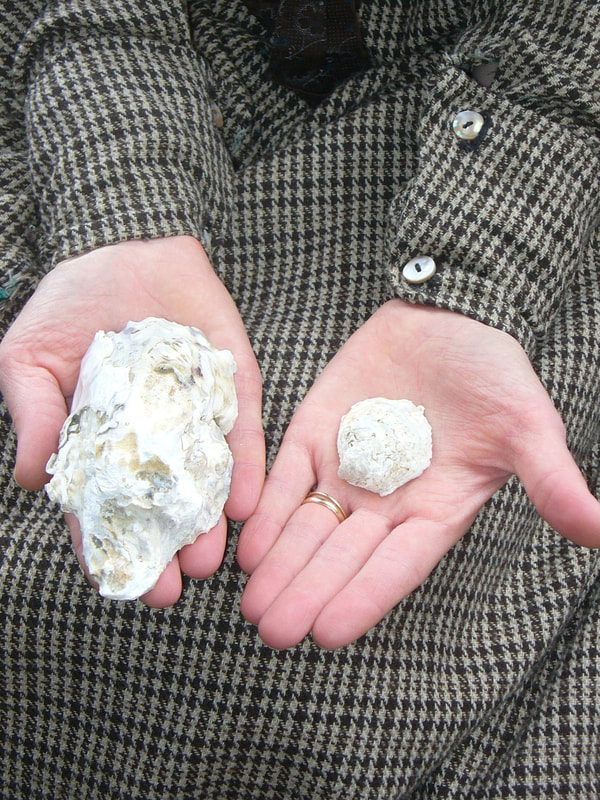The following passage and nineteenth-century recipes appear in Appendix II of A Trip and a Tumble, along with recipes for the other foods mentioned in the story. Enjoy!
At the time of this story, Olympia oysters were the only fresh oysters available in the Pacific Northwest; high demand due to their extreme popularity was depleting the supply. In 1881 the first efforts had made to "rebed" (what would now be termed "seed") more oysters, and in 1895 a French system of "parking" oysters (growing them on a system of dykes) was introduced to the region. These efforts helped the Olympia oyster rebound, but a combination of market forces and natural bad luck nearly wiped it out.
Much bigger Eastern (Atlantic) oysters were brought to Puget Sound and seeded in the local oyster beds as an experiment; later the Atlantic oysters would lose pride of place to even bigger and more profitable Pacific oysters introduced to the Northwest from Japan.
On the night of January 13, 1907, disaster hit the oysters of Puget Sound. An unusually low tide coincided with a freak cold snap, leaving them exposed to temperatures eighteen degrees below freezing. While this temperature would not be considered unusual in many parts of the world, it was fatal for many intertidal life forms on Puget Sound —especially the oysters, which froze to death in the frigid air before the tide could come in again. The loss to oyster growers was estimated at several hundred thousand dollars at the time, and the Olympia oyster was expected to be off the market entirely for five years.[2] The long-term impact was even more profound because the incident sped up the rate at which faster growing and more profitable oysters were superceding the little Olympias.
Today Olympia oysters are only cultivated in Totten Inlet at the south end of Puget Sound. To read about efforts to reintroduce Olympia oysters on a large scale around Puget Sound, go to <http://www.restorationfund.org/projects/olympiaoyster>. To buy Olympia oysters from a family on Totten Inlet which has been cultivating shellfish since 1890, go to <https://www.taylorshellfishfarms.com>
[1] Brenner, J.J. "Thurston County Oyster Industry." The Coast. March, 1909. p. 152.
[2] Stearns, Robert E.C., "Oysters of the West Coast." March, 1908. National Geographic, p. 225.
Beach, Anna. Clever Cooking, Seattle, Washington: Metropolitan Printing & Binding Co., 1896. p. 69.
2 cups of mushrooms (a few more or less will not matter)
1 pint of oysters
2 tablespoonfuls of butter
2 tablespoonfuls of flour
1/4 cup of sherry
Peel and break into small pieces the mushrooms and put them in a stewpan with a little water; cook until tender, stirring frequently. Heat the butter and stir into it the flour, rubbing smooth, add the cream gradually and let it boil up once. Add to this the mushrooms and oysters, season with salt and cayenne pepper and add the wine. Serve on toast.
***
Oyster Patties
Beach, Anna. Clever Cooking, Seattle, Washington: Metropolitan Printing & Binding Co., 1896. p. 69.
1 pint solid native oysters
1 saltspoonful salt
2 small tablespoonfuls flour
1 large tablespoonful butter
1 saltspoonful pepper
2 small cups milk
Yolks of 2 eggs
Stir your flour, pepper and salt in a little cold milk, then stir this into your boiling milk and add butter. When this is the consistency of cream, have a quart of boiling water and pour your oysters into it, and give them a shake or a stir with a spoon; then turn immediately into a colander, drain well, and stir them into your cream. Set over a slow fire for five minutes for oysters to finish cooking. Beat the yolks of the 2 eggs in a little milk and stir into your cream, then fill your shell. This will serve eight persons.
***
Oyster Kabobs
Beach, Anna. Clever Cooking, Seattle, Washington: Metropolitan Printing & Binding Co., 1896. p. 68.
Put 1 large tablespoonful of butter in a stewpan, add a small onion, chopped very fine, a dessert spoonful of parsley and a dozen mushrooms chopped; let these fry one minute; add 1 dessert spoonful (scant) of flour, stir well together; then drop in as many oysters as required, which have previously been blanched and bearded. Stir and add the beaten yolks of three eggs, one at a time, taking care they do not curdle but get just thick enough to adhere to the oysters. Take skewers and string 6 oysters onto each one, basting with the sauce wherever it does not adhere. Let these cook, then roll in beaten egg and abundant cracker meal, so that it looks like a sausage with a skewer run through lengthwise. Fry, in deep fat, two minutes. Great care must be taken to have the fat hot enough, about 380 to 400 degrees, so that the oysters will become a pale brown in that time, as they would become hard and tough if cooked longer. Serve on a napkin, allowing one skewer to each person.

 RSS Feed
RSS Feed